Unità 3 – Una giornata per il tempo libero
Learning Objectives – Unità tre – Una giornata per il tempo libero
In this unit students will learn how to talk about free time activities as well as being able to talk about the weather and what to wear in specific occasions.
From a cultural point of view we will focus our attention on the Milano Fashion Week and fashion designers.
3.1 – Le attività del tempo libero
A casa
Studia il vocabolario: “Le attività del tempo libero” e la grammatica “Verbi regolari e irregolari in -ERE”. ‘e completa gli esercizi su canvas.
3.2 – Interessi comuni
In classe
Vocabolario: “Le attività del tempo libero“
Grammatica “Verbi regolari e irregolari in -ERE”.
Attività 1 – Revisione vocabolario e coniugazione dei verbi regolari in -ERE
Lavorate in gruppo e unite i verbi alle immagini, poi usate il verbo in una frase.
Work in group and match the images with the verbs, then use the verb you picked for each image in a sentence.
| fare una passeggiata | sciare | leggere |
| correre | dipingere | giocare a carte |
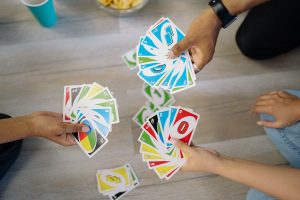 |
 |
 |
 |
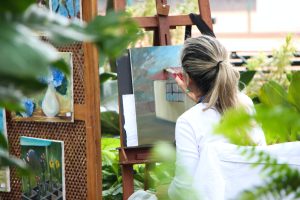 |
 |
Step 2 – Lavorate in gruppo. Guardate il video “Che cosa fai nel tempo libero” da 0: 44 a 2:52.
Ogni gruppo risponde alle domande sul personaggio collegato al suo gruppo. Scrivete le vostre risposte sul vostro quaderno.
Work in groups – watch the video then answer the questions related to the character for your group. Write all the examples you can hear from the character and write your answers in your notebook using the third person “lui/lei…” We will check the activity with the whole class.
| Gruppo 1 | Che cosa fa il professore nel tempo libero? |
| Gruppo 2 | Che cosa fa Gino nel tempo libero? |
| Gruppo 3 | Che cosa fa Dino nel tempo libero? |
| Gruppo 4 | Che cosa fa Lino nel tempo libero? |
Attività 2 – Il nostro tempo libero
Step 1 – Usa le tabelle sotto per parlare dei vostri interessi. Completa almeno 6 caselle di questa tabella con le attività che fai nel tempo libero.
Use the charts below to talk about what you do in your free time. Fill in at least 6 boxes in the chart below with the activities you do in your free time.
| Il mio tempo libero | |||||||
| lunedì | martedì | mercoledì | giovedì | venerdì | sabato | domenica | |
| mattina | |||||||
| pomeriggio | |||||||
| sera | |||||||
Step 2: Work in pairs and think about questions that you can ask to your classmates about their free time then check with your instructor: As for example:
What do you do on… / What sport do you do on… / When do you ….during the week? / Do you….on….
Step 3 – Trova il compagno – Use the link to the document for the following activity.
Gira per la classe e usa le domande dell’attività sopra per trovare chi fa le attività nella tabella sotto. Per ogni attività trova almeno un compagno, scrivi il suo nome e quando fa questa attività durante la settimana.
Walk around the class and find someone in your class that does the following activities. You the questions used in the previous step. For each activity ask your classmates and when you find someone write the name of the classmate and when they do the activity during the week.
| Attività | Nome del compagno | Quando fa questa attività? |
| fare sport. (Quale sport pratica?) | ||
| chattare con gli amici | ||
| ascoltare un podcast | ||
| guardare video su youtube | ||
| andare al cinema | ||
| fare una passeggiata | ||
| correre | ||
| scrivere un’email | ||
| andare in bicicletta | ||
| fare una festa | ||
| leggere un libro |
Step 4 – Racconta ai tuoi compagni di classe che cosa fai nel tempo libero e che cosa fa il tuo compagno / la tua compagna.
Tell the class what you do in your free time and what your classmate does. Use io / lui-lei / noi if you do something together or have something in common.
3.3 – Lo sport in Italia
A casa
Studia il vocabolario: “Le attività del tempo libero e la grammatica “Il verbo piacere” su questo libro e completa gli esercizi . Vai su Blinklearning. e completa gli esercizi con il voto.
Study the vocabulary and the grammar then do the exercises embedded in this book at your own pace while you study. Please follow this link to complete graded activities Blinklearning.
Leggiamo#3
Lo sport in Italia
Go to Canvas to complete Leggiamo#3
Gli italiani amano molto fare sport e guardare le gare sportive di tutte le discipline. Tutti gli italiani tifano per gli “Azzurri”, gli atleti che giocano nella squadra nazionale italiana nei diversi sport.
Il calcio è lo sport più popolare in Italia. Ogni città Italiana ha una oppure due squadre che competono a livello nazionale e tantissime altre squadre che competono a livello provinciale, regionale e comunale.
Le squadre di calcio più famose sono Juventus, Inter, Milan, Lazio, Roma etc. e gareggiano per la vittoria dello scudetto. Il Napoli vince lo scudetto nel 2023.
Altri sport famosi in Italian sono l’automobilismo e il ciclismo.
L’automobilismo è famoso grazie alla Ferrari e alle gare di Formula 1 (F1). La Ferrari è l’unica scuderia che partecipa alla F1 dal 1950 ad oggi. La Ferrari vince 16 campionati mondiali con diversi piloti. Il pilota con più vittorie in Ferrari è Michael Schumacher. Le Ferrari si chiamano anche “Le Rosse” di Maranello (Maranello è una piccola città dove costruiscono la Ferrari).
Gli Italiani seguono anche il “Giro d’Italia”, una corsa in bicicletta con tappe in tutta Italia. La gara si svolge tra la fine di maggio e l’inizio di giugno.
Tra gli altri sport popolari ci sono il nuoto, lo sci, la pallacanestro, la pallavolo e il tennis.
Ci sono altri sport meno seguiti, ma in queste categorie “gli Azzurri” vincono sempre molte medaglie ai campionati europei, mondiali e anche alle Olimpiadi. Tra questi sport ci sono: la palla a nuoto, la scherma, l’atletica leggera, l’equitazione e il canottaggio, il nuoto sincronizzato, il lancio del peso.
Ma chi sono gli atleti italiani con più vittorie?
Matteo Berrettini: è un campione di tennis italiano. Lui vince due volte al Queen’s a Londra e arriva secondo alla finale di Wimbledon nel 2021.
Bebe Vio: è una campionessa paralimpica di scherma. Bebe vince 2 medaglie d’oro alle Olimpiadi di Tokio nel 2021 e di Rio de Janeiro nel 2016. In totale nella sua carriera vince 11 medaglie d’oro.
Sofia Goggia: Vince la coppa nei campionati mondiali di sci per tre anni seguenti dal 2021 al 2023.
Marcel Jacobs: è un atleta italo-americano, nasce a El Paso in Texas, ma vive in Italia da quando è bambino. Vince la medaglia d’oro alle olimpiadi di Tokio nella corsa 100m e batte il record mondiale.
3.4 – Che cosa ti piace?
In classe
Vocabolario: “Le attività del tempo libero
Grammatica “Il verbo piacere”
Attività 1 – You can use the following document Attività Visita Aosta to fill the charts in activity 1 and 2
Situazione: Tu e il tuo amico parlate delle vostre preferenze sportive.
Situation: You and your friend talk about your preferences regarding sports.
Compito: Completate la tabella qui sotto e poi giocate a due verità e una bugia.
Task: Fill in the chart below and then play two truths and a lie.
Step 1
Guardate il video “Visita Aosta” e completate la tabella sottostante con almeno due esempi per ogni stagione.
Watch the video and fill in the chart below with at least 2 examples for each season.
| autunno | inverno | primavera | estate | |
| sport | ||||
| altre attività |
Step 2
Sul tuo quaderno completa la tabella sotto con quello che ti piace e quello che non ti piace. Fai un esempio per ogni categoria: sport, squadra, atleta famoso, attività del tempo libero.
In your notebook fill in the chart below with things that you like or dislike (one example for each category: sport, team, famous athlete, free time activity)
| Mi piace moltissimo/tantissimo
oppure Mi piacciono moltissimo/ tantissimo |
Mi piace molto / mi piace un sacco
oppure Mi piacciono molto / mi piacciono un sanno |
Mi piace abbastanza
oppure Mi piacciono abbastanza |
Non mi piace
oppure Non mi piacciono |
Non mi piace tanto
oppure Non mi piacciono tanto |
Non mi piace per niente
oppure Non mi piacciono per niente |
|
| Sport | ||||||
| Squadra | ||||||
| Atleta famoso | ||||||
| Attività del tempo libero |
Riflettiamo: Il verbo Piacere
Check your sentences and then complete the rule below.
- Piace il always followed by ____________and __________
- Piacciono is always followed by ___________
Read the following sentences and discuss with the other classmates the position of the adverbs: molto, poco, tanto, abbastanza, per niente etc.
- Mi piace molto la pizza.
- Non mi piace per niente il Gatorade.
Step 3 – Play two truths and a lie with your classmates. Each student should have a turn to guess the lie of the other student(s).
Step 4 – Play with the whole class.
Attività 2 – Talk about famous Italian athletes
Situazione: Raccogliere informazioni e parlare di atleti famosi italiani.
Situation: Collect information and talk about famous Italian athletes.
Compito: Lavorate in coppia e usate le pagine instagram di atleti famosi italiani per raccogliere informazioni.
Homework: Use the Instagram pages of the Italian famous athletes and collect information then share them with other classmates.
Step 1 – Lavorate in coppie sul documento Atleti Famosi Ogni coppia lavora su un atleta.
Work in pairs on the document Atleti Famosi and pick one athlete per pair.
Step 2 Gli studenti si fanno domande a vicenda per completare le informazioni che mancano nella loro parte della tabella. Usate i profili instagram allegati e Internet per trovare maggiori informazioni sugli atleti.
Look at only one column of the chart (studente 1 or studente 2) and ask questions to the other student about the information that he/she doesn’t have in his/her column. You can use Instagram and Internet to fill the information that neither of you have.
Step 3 – Guardate il profilo instagram dell’atleta e fate tre esempi di cosa fa nel tempo libero.
Check the instagram and make examples of what they do in their free time.
Step 4: In plenaria fate domande sugli atleti e rispondete.
Ask and answer questions about the athletes with the whole class.
3.5 – Che tempo fa
A casa
Study the vocabulary “I mesi, le stagioni e il tempo” and the grammar “Espressioni con Avere” su questo libro e completa gli esercizi .
Le previsioni del tempo
Go to Canvas to complete Ascoltiamo #3
Watch the video Le previsioni del Tempo – Weather Forecast in Italian on Youtube and then complete the comprehension questions on Canvas.
Be ready to answer the following questions in class
- Tu che cosa indossi quando hai freddo?
- Che cosa fai quando hai caldo?
- Che tempo fa oggi ad Austin?
3.6 – L’abbigliamento
Studia il vocabolario “I mesi e le stagioni” – “l’abbigliamento” e la grammatica “verbi regolari e irregolari in -IRE.” su questo libro e completa gli esercizi .
3.7 – Che bel vestito
In classe
Studia il vocabolario “I mesi e le stagioni” – “l’abbigliamento”
Grammatica “verbi regolari e irregolari in -IRE”
Revisione dei verbi in -are / -ere / ire – Domande con Wordwall
Attività 1 – Che cosa indossi?
Step 1 – Lavorate in coppia e cercate su questo sito “Meteo nel mondo” il tempo atmosferico in una città a vostra scelta poi rispondete alle domande seguenti.
Work in pairs and look for the weather forecast of a city of your choice on this website “Meteo nel mondo” then answer to the following questions,
- Quale città scegliete?
- Che tempo fa oggi?
- Quanti gradi ci sono?
Step 2 – Lavorate in gruppi di 3 o 4 persone, guarda qualche minuto del video What people are wearing in Italy – Urban Outfit 2023 (Riccione) .
e rispondete alle seguenti domande:
- Che tempo fa a Riccione?
- Che cosa fanno queste persone?
- Secondo te, dove vanno?
- Che cosa indossano?
Step 3 – Lavorate in gruppi, fate partire il video What people are wearing in Italy – Urban Outfit 2023 (Riccione) .e fermate su una immagine. Ogni studente sceglie una persona e descrive che cosa indossa. Poi insieme scrivete alcune frasi su quali capi di abbigliamento preferite e quali no.
Work in groups, start the video What people are wearing in Italy – Urban Outfit 2023 (Riccione) .and stop on one image, each student describes one person in that image and then together write a few sentences about what items do you prefer.
Esempio: preferisco questo cappello, ma non mi piacciono quelle scarpe.
Step 4 – leggete le vostre frasi in plenaria.
Riflettiamo: L’aggettivo e il pronome dimostrativo
A. Fill the chart with the correct form of the adjective Questo – (this / these) then discuss with your classmate the rule of formation
| Singolare | Plurale | |
| Maschile | ________maglione è nuovo | _______pantaloni non mi piacciono |
| Femminile | ________camicia è costosa | _______scarpe sono scomode |
B. Read the sentences below and discuss with your classmates the rule of formation for the adjective Quello – (that / those)
- Quel professore è serio.
- Quella è la macchina di Mario.
- Non compro quell’abito perché troppo lungo.
- Ho bisogno di quelle scarpe in inverno.
- Gli studenti non usano quegli zaini.
C. I pronomi dimostrativi – Look at the chart and discuss how are the Pronomi dimostrativi used in Italian.
| Maschile | Femminile | |
| Singolare | questo (this) / quello (that)
Quale cappello preferisci? Questo rosso o quello verde? |
questa (this) / quella (that)
Quale gonna preferisci? Questa lunga o quella corta? |
| Plurale | questi (these) / quelli (those)
Quali stivali preferisci? Questi marroni o quelli neri? |
queste (these) / quelle (those)
Quali borse preferisci? Queste grandi o quelle piccole? |
Esercizio 1 – You can use this as review on Thursday.
Match the given words to the images. A word can describe more images.
pantaloni / borsa / impermeabile / scarpe / zaino / pantaloncini / giacca
| Immagine 1 | Immagine 2 | Immagine 1 | Immagine 2 | ||
| Gruppo A | 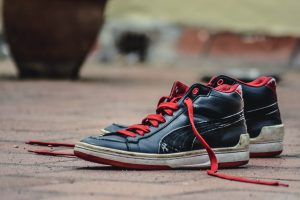 |
 |
Gruppo C |  |
 |
| Immagine 1 | Immagine 2 | Immagine 1 | Immagine 2 | ||
| Gruppo B | 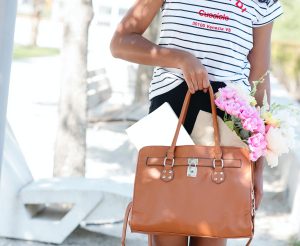 |
 |
Gruppo D |  |
 |
Step 4 –
Per ogni gruppo di immagini, descrivete gli oggetti e fate domandi su quale capo di abbligliamento preferite come nell’esempio sotto. For each group of images describe the objects you see and ask and answer questions about the item you prefer, as in the example below.
Esempio:
Questa sciarpa è azzurra, ma quella sciarpa è colorata.
Quale sciarpa preferisci? Quella azzurra o quella colorata? Preferisco quella colorata. Che bella sciarpa!
 |
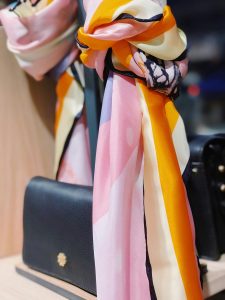 |
3.8 – I miei interessi
A casa
Studia il vocabolario Review: “Le stagioni” – “l’abbigliamento” e Grammatica Review “verbi regolari e irregolari in -IRE”
Grammatica Study: Le preposizioni semplici
Parliamo 3
I miei interessi
Go to Canvas to complete Parliamo#3
Leggi le domande e poi registra un video messaggio in cui rispondi alle domande con frasi complete in Italiano.
- Ti piace fare sport? Quale sport pratichi?
- Che cosa fai nel tempo libero?
- Che cosa sai fare e che cosa non sai fare?
- Che cosa indossi quando esci con gli amici?
L’angolo della Pronuncia 3 – I suoni SC / SCH
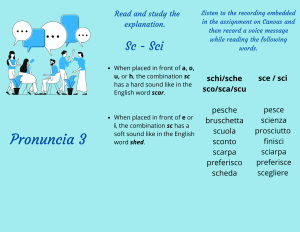
3.9 – Facciamo spese!
In classe
Studia il vocabolario “Le stagioni” – “l’abbigliamento”
Grammatica Review:
“Verbi regolari e irregolari in -ERE”.
“verbi regolari e irregolari in -IRE”
Scriviamo 3
Write a composition of 50 – 60 words in Italian about the following topics.
- Qual è il tuo sport preferito?
- Dove, quando e con chi preferisci guardare le partite?
- Che cosa indossano i giocatori?
While you write your composition, make sure to use the grammar structures and vocabulary studied in this unit.
Lettura culturale
La settimana della moda di Milano[1]
Lavorate in gruppo di 4 studenti e a turno leggete ad alta voce il testo seguente, poi rispondete oralmente alle domande di comprensione.
Work in group of 4 students and take turns reading aloud the following article, then orally answer to the comprehension questions below.
Arte, cibo, musica e moda sono i quattro pilastri del Made in Italy. Tra le capitali della moda nel mondo ci sono Parigi, Milano, New York e Londra. In Italia le tre città simbolo per la moda sono Milano, Firenze e Roma.
In Italia, la città più famosa per la moda è Milano perché ha una posizione strategica e molte connessioni internazionali.
Il Quadrilatero della moda è il centro della moda a Milano. Le strade che formano il Quadrilatero della moda sono quattro: via Monte Napoleone, via Manzoni, via della Spiga e corso Venezia. In queste strade ci sono molti negozi, showroom e gioiellerie. Numerosi turisti arrivano da tutto il mondo per fare spese in queste vie di Milano.
Qui c'è anche la Camera Nazionale della Moda Italiana, che dal 1958 coordina gli eventi del settore della moda. In particolare la settimana della moda che si svolge quattro volte all'anno: a gennaio e a giugno per la moda uomo e a febbraio e a settembre per la moda donna.
La Milano Fashion Week ritorna dal 25 febbraio al 3 marzo per l'edizione dedicata alla moda autunno-inverno 2026. Il calendario di eventi è fittissimo, tra sfilate, presentazioni ed eventi esclusivi in tutta la città dedicati al luccicante (shimmering) mondo della moda.
Il calendario definitivo dell'evento comprende 64 sfilate, di cui 5 digitali, 74 presentazioni e 34 eventi, per un totale di 172 eventi,
Anche per questa stagione la Camera Nazionale della Moda offre la possibilità di seguire gli eventi online, tramite milanofashionweek.cameramoda.it.
Rispondi alle domande di comprensione e poi cerca nel testo le informazioni corrette per le risposte sbagliate.
Read the comprehension questions and then look in the articles for the correct information to the wrong answers.
- L'associazione che organizza la settimana della moda si chiama: Quadrilatero V- F
- Il Quadrilatero della moda sono quattro strade di Milano. V - F
- In autunno gli stilisti presentano le collezioni per l'inverno 2025. V - F
- I quattro pilastri del Made in Italy sono: cinema, moda, cibo e musica V - F
- Le persone seguono le sfilate online e in presenza V - F
- I turisti non comprano i vestiti nel Quadrilatero della Moda V - F
- This article was taken and adapted for educational purposes from [footnote]https://www.milanoweekend.it/articoli/fashion-week-2024-milano-eventi/ ↵
cheer
popular
compete
patch
team
driver / pilot
stop
takes place
less
pillars
fashion
jewelry store
takes place
busy
includes

